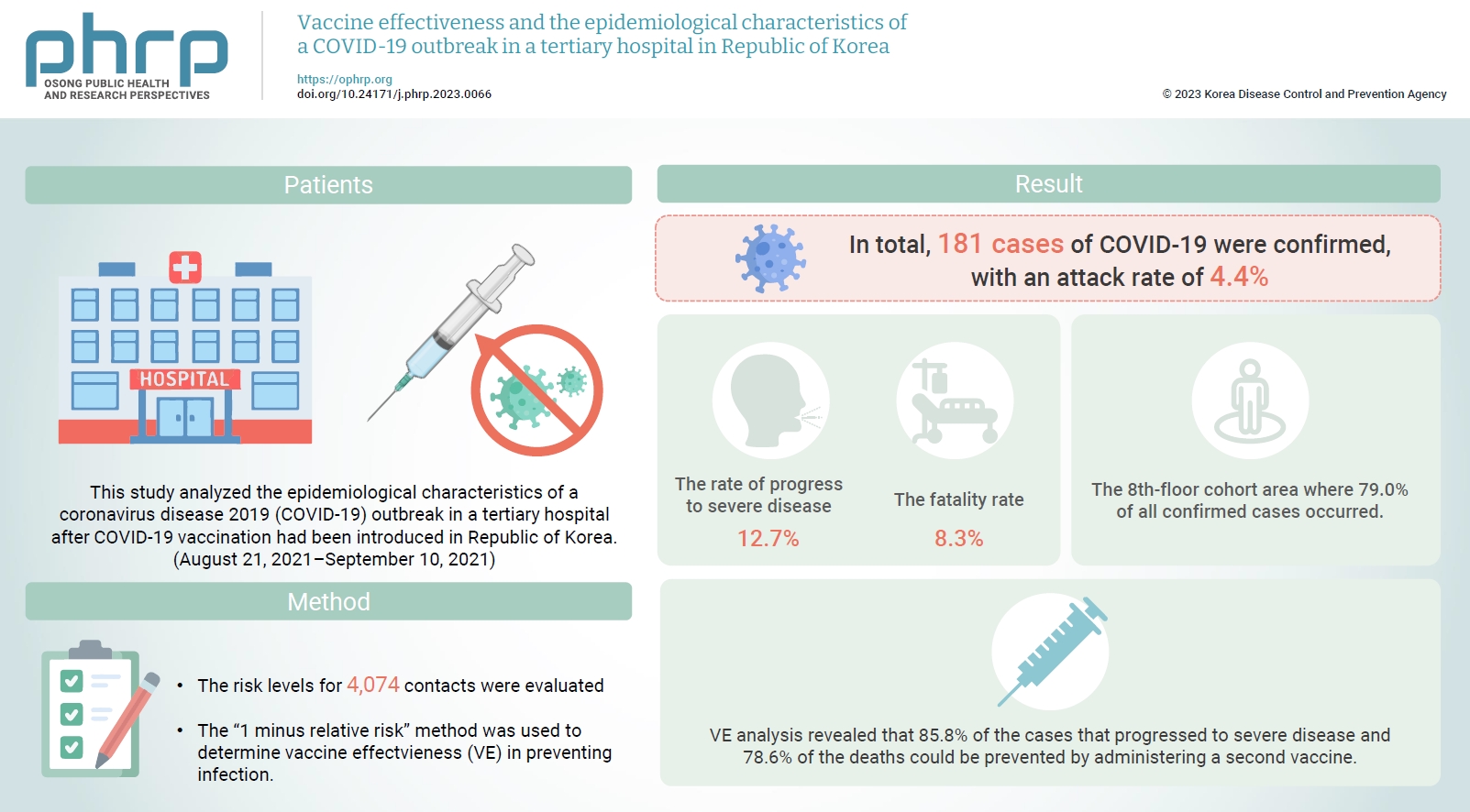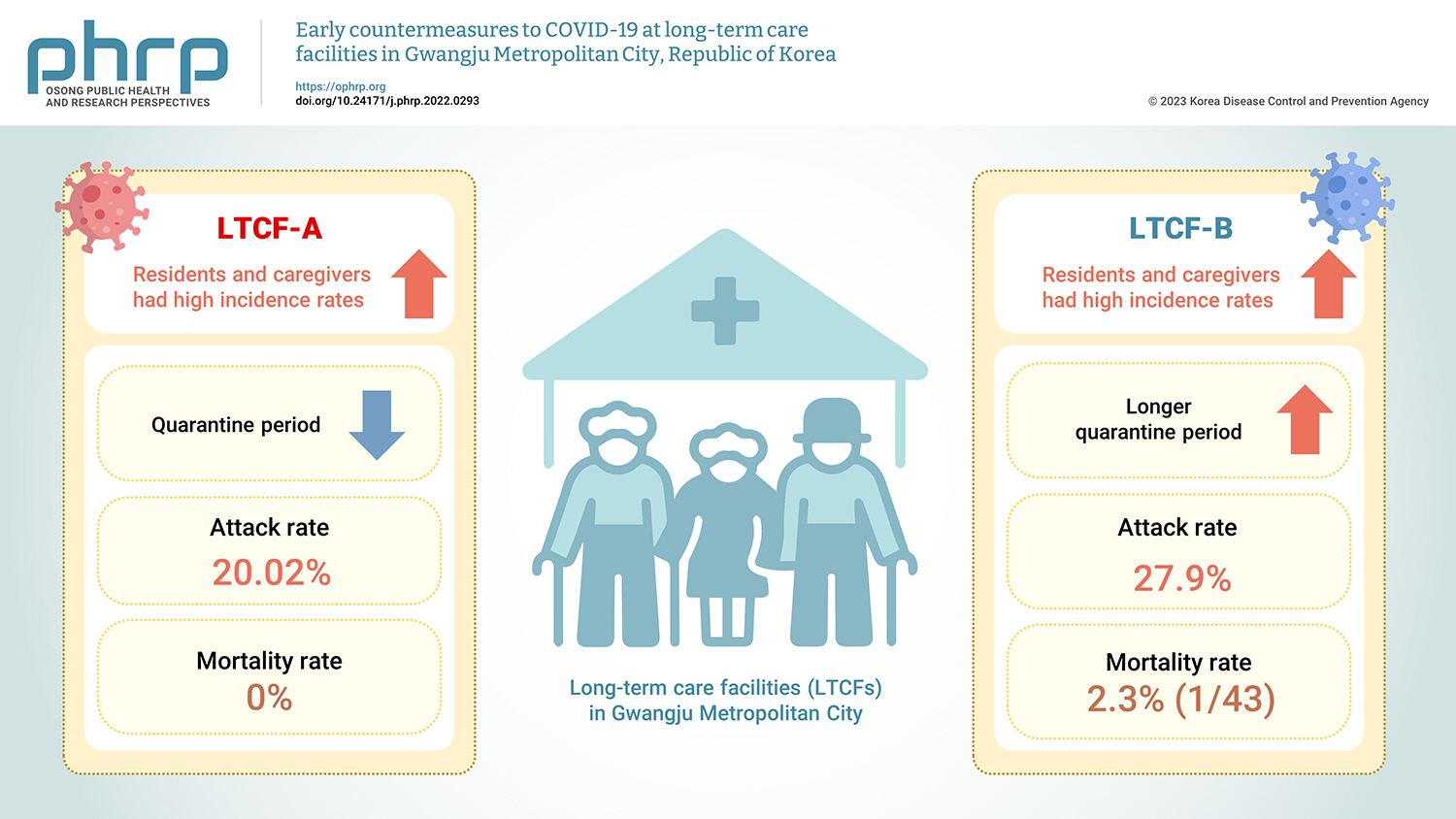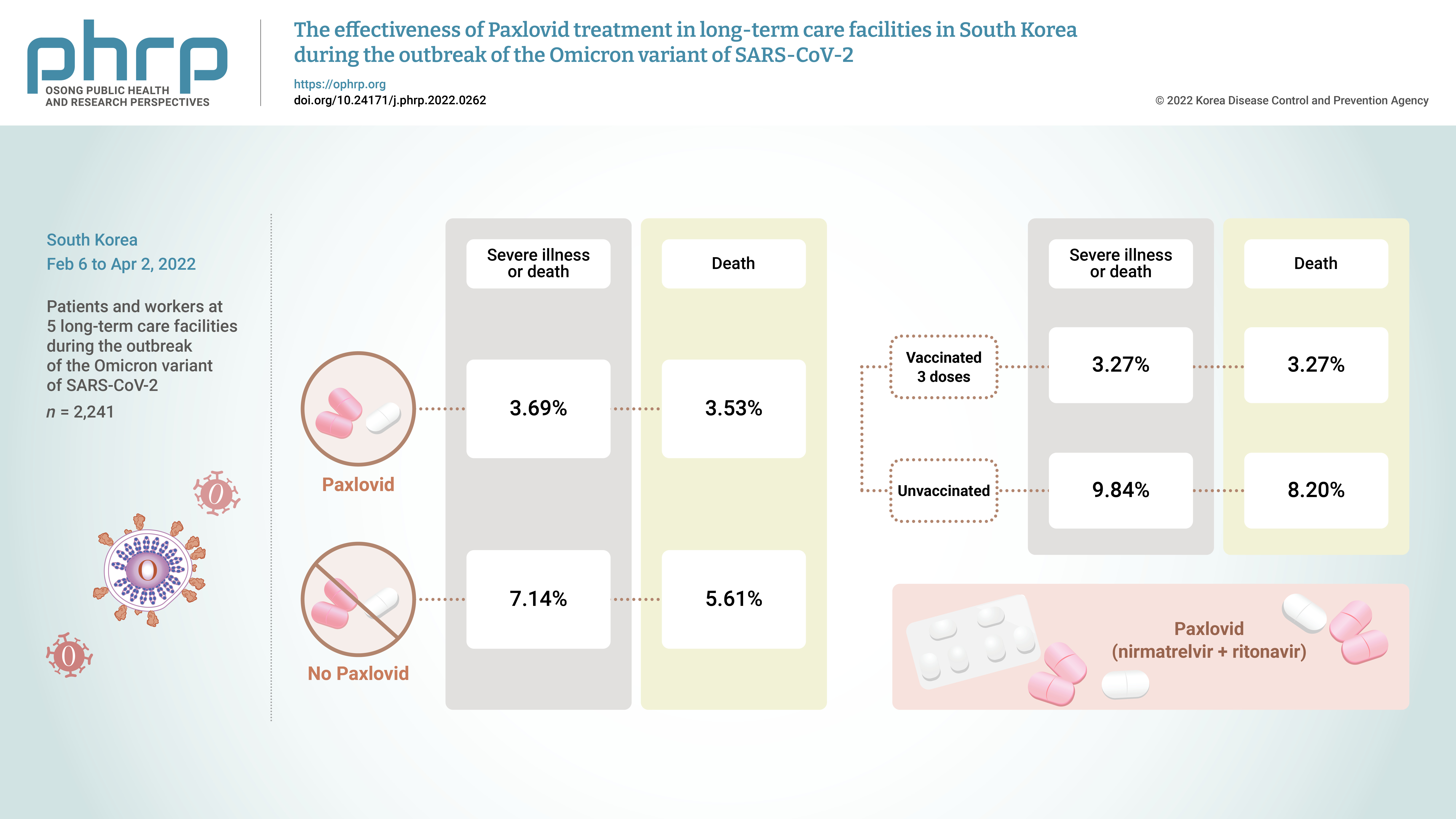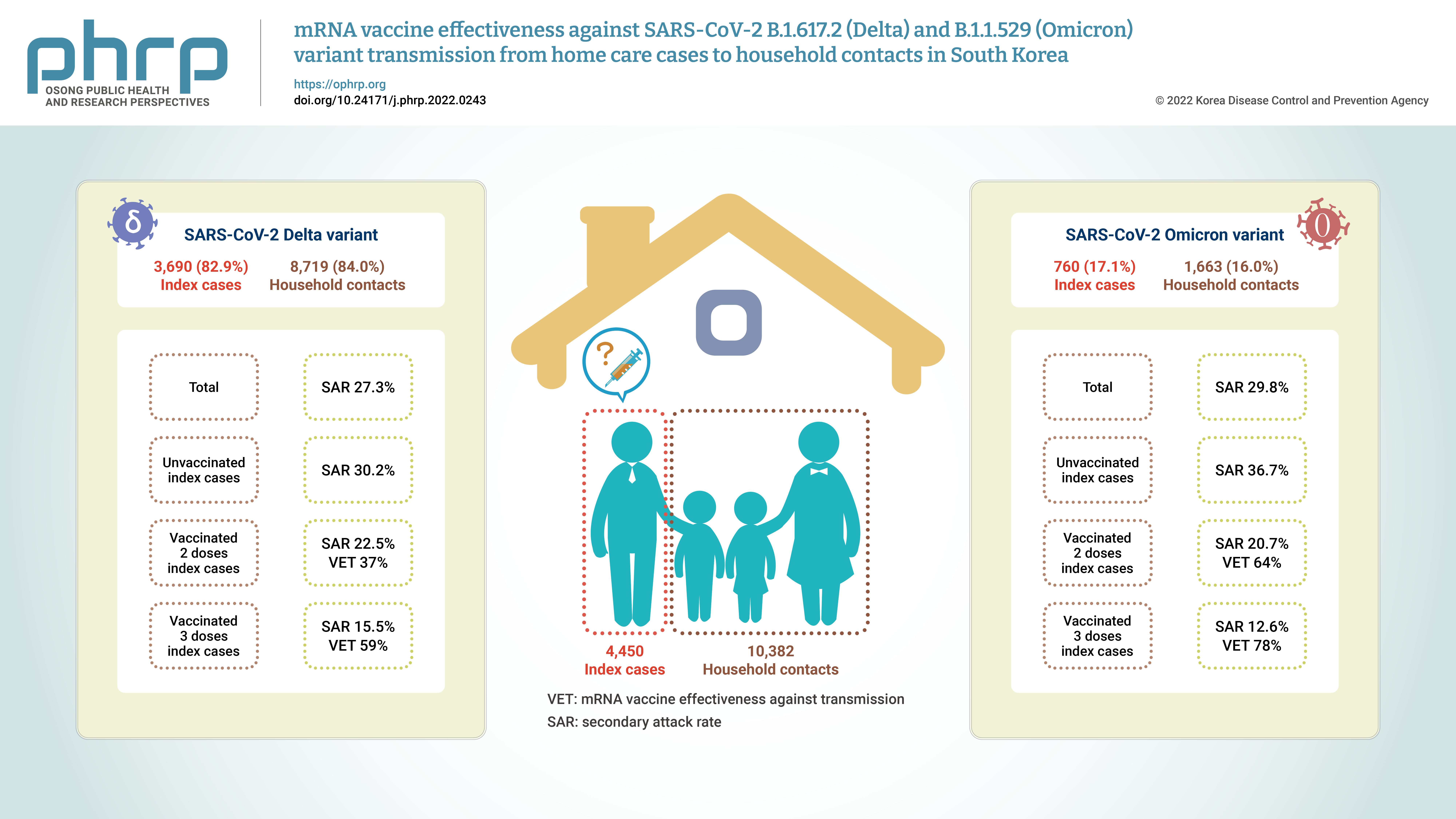Search
- Page Path
- HOME > Search
- Estimating the number of severe COVID-19 cases and COVID-19-related deaths averted by a nationwide vaccination campaign in Republic of Korea
- Ji Hae Hwang, Ju Hee Lee, Eun Jung Jang, Ryu Kyung Kim, Kil Hun Lee, Seon Kyeong Park, Sang Eun Lee, Chungman Chae, Sangwon Lee, Young Joon Park
- Osong Public Health Res Perspect. 2023;14(3):164-172. Published online June 22, 2023
- DOI: https://doi.org/10.24171/j.phrp.2023.0096
- 1,751 View
- 117 Download
- 1 Web of Science
- 1 Crossref
-
 Graphical Abstract
Graphical Abstract
 Abstract
Abstract
 PDF
PDF 
- Objectives
The Korea Disease Control and Prevention Agency promotes vaccination by regularly providing information on its benefits for reducing the severity of coronavirus disease 2019 (COVID-19). This study aimed to analyze the number of averted severe COVID-19 cases and COVID-19-related deaths by age group and quantify the impact of Republic of Korea’s nationwide vaccination campaign.
Methods
We analyzed an integrated database from the beginning of the vaccination campaign on February 26, 2021 to October 15, 2022. We estimated the cumulative number of severe cases and COVID-19-related deaths over time by comparing observed and estimated cases among unvaccinated and vaccinated groups using statistical modeling. We compared daily age-adjusted rates of severe cases and deaths in the unvaccinated group to those in the vaccinated group and calculated the susceptible population and proportion of vaccinated people by age.
Results
There were 23,793 severe cases and 25,441 deaths related to COVID-19. We estimated that 119,579 (95% confidence interval [CI], 118,901–120,257) severe COVID-19 cases and 137,636 (95% CI, 136,909–138,363) COVID-19-related deaths would have occurred if vaccination had not been performed. Therefore, 95,786 (95% CI, 94,659–96,913) severe cases and 112,195 (95% CI, 110,870–113,520) deaths were prevented as a result of the vaccination campaign.
Conclusion
We found that, if the nationwide COVID-19 vaccination campaign had not been implemented, the number of severe cases and deaths would have been at least 4 times higher. These findings suggest that Republic of Korea’s nationwide vaccination campaign reduced the number of severe cases and COVID-19 deaths. -
Citations
Citations to this article as recorded by- Comparative Effectiveness of COVID-19 Bivalent Versus Monovalent mRNA Vaccines in the Early Stage of Bivalent Vaccination in Korea: October 2022 to January 2023
Ryu Kyung Kim, Young June Choe, Eun Jung Jang, Chungman Chae, Ji Hae Hwang, Kil Hun Lee, Ji Ae Shim, Geun-Yong Kwon, Jae Young Lee, Young-Joon Park, Sang Won Lee, Donghyok Kwon
Journal of Korean Medical Science.2023;[Epub] CrossRef
- Comparative Effectiveness of COVID-19 Bivalent Versus Monovalent mRNA Vaccines in the Early Stage of Bivalent Vaccination in Korea: October 2022 to January 2023
- Vaccine effectiveness and the epidemiological characteristics of a COVID-19 outbreak in a tertiary hospital in Republic of Korea
- Seonhee Ahn, Tae Jong Son, Yoonsuk Jang, Jihyun Choi, Young Joon Park, Jiseon Seong, Hyun Hee Kwon, Muk Ju Kim, Donghyok Kwon
- Osong Public Health Res Perspect. 2023;14(3):188-196. Published online June 8, 2023
- DOI: https://doi.org/10.24171/j.phrp.2023.0066
- 1,471 View
- 72 Download
-
 Graphical Abstract
Graphical Abstract
 Abstract
Abstract
 PDF
PDF 
- Objectives
Healthcare facilities are high-risk sites for infection. This study analyzed the epidemiological characteristics of a coronavirus disease 2019 (COVID-19) outbreak in a tertiary hospital after COVID-19 vaccination had been introduced in Republic of Korea. Vaccine effectiveness (VE) and shared anti-infection strategies are also assessed.
Methods
The risk levels for 4,074 contacts were evaluated. The epidemiological characteristics of confirmed cases were evaluated using the chi-square test. The “1 minus relative risk” method was used to determine VE in preventing infection, progression to severe disease, and death. In the largest affected area (the 8th floor), a separate relative risk analysis was conducted. A multivariate logistic regression analysis (with 95% confidence interval [CIs]) was used to identify transmission risk factors with a significance level <10% via the backward elimination method.
Results
In total, 181 cases of COVID-19 were confirmed, with an attack rate of 4.4%. Of those cases, 12.7% progressed to severe disease, and 8.3% died. In the cohort isolation area on the 8th floor, where 79.0% of the confirmed cases occurred, the adjusted odds ratio was 6.55 (95% CI, 2.99–14.33) and 2.19 (95% CI, 1.24–3.88) for caregivers and the unvaccinated group, respectively. VE analysis revealed that 85.8% of the cases that progressed to severe disease and 78.6% of the deaths could be prevented by administering a second vaccine.
Conclusion
Caregiver training for infection prevention and control is necessary to reduce infection risk. Vaccination is an important intervention to reduce the risk of progression to severe disease and death.
- Early countermeasures to COVID-19 at long-term care facilities in Gwangju Metropolitan City, Republic of Korea
- Hye-Jin Kim, Jieun Kim, Yoon Suk Jang, Hanul Park, Jong Mu Kim, Young Joon Park, So-Yeon Ryu, Jun Hwi Cho, So Yeong Park, Sang-Eun Lee
- Osong Public Health Res Perspect. 2023;14(1):59-65. Published online February 1, 2023
- DOI: https://doi.org/10.24171/j.phrp.2022.0293
- 1,909 View
- 79 Download
-
 Graphical Abstract
Graphical Abstract
 Abstract
Abstract
 PDF
PDF 
- Objectives
The coronavirus disease 2019 (COVID-19) pandemic has continued since its first detection in the Republic of Korea on January 20, 2020. This study describes the early countermeasures used to minimize the risk of COVID-19 outbreaks during cohort quarantine and compares the epidemiological characteristics of 2 outbreaks in long-term care facilities (LTCFs) in Gwangju Metropolitan City in summer 2020. Methods: An epidemiological investigation was conducted via direct visits. We investigated epidemiological characteristics, including incidence, morbidity, and mortality rates, for all residents and staff members. Demographic characteristics were analyzed using a statistical program. Additionally, the method of managing infection in LTCFs is described. Results: Residents and caregivers had high incidence rates in LTCF-A and LTCF-B, respectively. LTCF-B had a longer quarantine period than LTCF-A. The attack rate was 20.02% in LTCF-A and 27.9% in LTCF-B. The mortality rate was 2.3% (1/43) in LTCF-B, the only facility in which a COVID-19 death occurred. Conclusion: Extensive management requires contact minimization, which involves testing all contacts to mitigate further transmission in the early stages of LTCF outbreaks. The findings of this study can help inform and prepare public health authorities for COVID-19 outbreaks, particularly for early control in vulnerable facilities.
- The effectiveness of Paxlovid treatment in long-term care facilities in South Korea during the outbreak of the Omicron variant of SARS-CoV-2
- Hanul Park, Young Joon Park, Hye Young Lee, Mi Yu, Yeong-Jun Song, Sang Eun Lee, Ji-Joo Lee, Eun-Sol Lee, Yeonjung Kim
- Osong Public Health Res Perspect. 2022;13(6):443-447. Published online December 23, 2022
- DOI: https://doi.org/10.24171/j.phrp.2022.0262
- 3,440 View
- 216 Download
- 7 Web of Science
- 9 Crossref
-
 Graphical Abstract
Graphical Abstract
 Abstract
Abstract
 PDF
PDF 
- Objectives
On November 5, 2021, Pfizer Inc. announced Paxlovid (nirmatrelvir +ritonavir) asa treatment method that could reduce the risk of hospitalization or death for patients withconfirmed coronavirus disease 2019 (COVID-19).Methods: From February 6, 2022 to April 2, 2022, the incidence of COVID-19 and the effectsof treatment with Paxlovid were analyzed in 2,241 patients and workers at 5 long-term carefacilities during the outbreak of the Omicron variant of severe acute respiratory syndromecoronavirus 2 in South Korea.Results: The rate of severe illness or death in the group given Paxlovid was 51% lower thanthat of the non-Paxlovid group (adjusted risk ratio [aRR], 0.49; 95% confidence interval [CI],0.24−0.98). Compared to unvaccinated patients, patients who had completed 3 doses of thevaccine had a 71% reduced rate of severe illness or death (aRR, 0.29; 95% CI, 0.13−0.64) and a65% reduced death rate (aRR, 0.35; 95% CI, 0.15−0.79).Conclusion: Patients given Paxlovid showed a lower rate of severe illness or death and alower fatality rate than those who did not receive Paxlovid. Patients who received 3 dosesof the vaccine had a lower rate of severe illness or death and a lower fatality rate than theunvaccinated group. -
Citations
Citations to this article as recorded by- Efficacy and safety of antiviral treatments for symptomatic COVID-19 outpatients: Systematic review and network meta-analysis
Meital Zur, Thalia Peselev, Stav Yanko, Victoria Rotshild, Ilan Matok
Antiviral Research.2024; 221: 105768. CrossRef - Clinical Effectiveness of Ritonavir-Boosted Nirmatrelvir—A Literature Review
Sydney Paltra, Tim O. F. Conrad
Advances in Respiratory Medicine.2024; 92(1): 66. CrossRef - Effectiveness of nirmatrelvir‐ritonavir on severe outcomes of COVID‐19 in the era of vaccination and Omicron: An updated meta‐analysis
Sien Ombelet, Diego Castanares‐Zapatero, Fabian Desimpel, Frank Hulstaert, Sabine Stordeur, Dominique Roberfroid
Journal of Medical Virology.2024;[Epub] CrossRef - COVID‐19 infection in patients with haematological malignancies: A single‐centre survey in the latest Omicron wave in China
Xiaolu Zhu, Qian Jiang, Jin Lu, Yuqian Sun, Xiaosu Zhao, Shenmiao Yang, Feifei Tang, Wenjing Yu, Ting Zhao, Xiaohong Liu, Jinsong Jia, Wenbing Duan, Lijuan Hu, Jing Wang, Yang Liu, Nan Peng, Xuelin Dou, Rui Ma, Qiang Fu, Huifang Wang, Kaiyan Liu, Xiaojun
British Journal of Haematology.2023; 202(1): 31. CrossRef - The association mental health of adolescents with economic impact during the COVID-19 pandemic: a 2020 Korean nationally representative survey
Hanul Park, Kang-Sook Lee
BMC Public Health.2023;[Epub] CrossRef - Efficacy and safety of paxlovid (nirmatrelvir/ritonavir) in the treatment of COVID‐19: An updated meta‐analysis and trial sequential analysis
Haokun Tian, Changsen Yang, Tiangang Song, Kechen Zhou, Lequan Wen, Ye Tian, Lirui Tang, Weikai Xu, Xinyuan Zhang
Reviews in Medical Virology.2023;[Epub] CrossRef - Real-World Effectiveness of Nirmatrelvir-Ritonavir and Its Acceptability in High-Risk COVID-19 Patients
Min-Kyung Kim, Kyung-Shin Lee, Sin Young Ham, Youn Young Choi, Eunyoung Lee, Seungjae Lee, Bora Lee, Jaehyun Jeon, BumSik Chin, Yeonjae Kim, Gayeon Kim, Hee-Chang Jang, Jae-Phil Choi, Sang-Won Park
Journal of Korean Medical Science.2023;[Epub] CrossRef - Effectiveness of Molnupiravir Treatment in Patients with COVID-19 in Korea: A Propensity Score Matched Study
Hye Rim Park, Min-Gyu Yoo, Jong Mu Kim, Soon Jong Bae, Hyungmin Lee, Jungyeon Kim
Infection & Chemotherapy.2023; 55(4): 490. CrossRef - Nirmatrelvir combined with ritonavir for preventing and treating COVID-19
Stefanie Reis, Maria-Inti Metzendorf, Rebecca Kuehn, Maria Popp, Ildiko Gagyor, Peter Kranke, Patrick Meybohm, Nicole Skoetz, Stephanie Weibel
Cochrane Database of Systematic Reviews.2023;[Epub] CrossRef
- Efficacy and safety of antiviral treatments for symptomatic COVID-19 outpatients: Systematic review and network meta-analysis
- mRNA vaccine effectiveness against SARS-CoV-2 B.1.617.2 (Delta) and B.1.1.529 (Omicron) variant transmission from home care cases to household contacts in South Korea
- Hanul Park, Young Joon Park, Sang Eun Lee, Min Jei Lee, Hyungtae Ahn
- Osong Public Health Res Perspect. 2022;13(6):435-442. Published online November 28, 2022
- DOI: https://doi.org/10.24171/j.phrp.2022.0243
- 4,764 View
- 171 Download
- 1 Web of Science
- 1 Crossref
-
 Graphical Abstract
Graphical Abstract
 Abstract
Abstract
 PDF
PDF 
- Objectives
Household contacts of confirmed cases of coronavirus disease 2019 (COVID-19) areexposed to a high risk of viral transmission, and secondary incidence is an important indicatorof community transmission. This study analyzed the secondary attack rate and mRNA vaccineeffectiveness against transmission (VET) for index cases (patients treated at home) confirmedto be infected with the Delta and Omicron variants.Methods: The subjects of the study were 4,450 index cases and 10,382 household contacts.Logistic regression analysis was performed to compare the secondary attack rate byvaccination status, and adjusted relative risk and 95% confidence intervals were identified.Results: The secondary attack rate of the Delta variant was 27.3%, while the secondary attackrate of the Omicron variant was 29.8%. For the Delta variant, groups with less than 90 daysand more than 90 days after 2 doses of mRNA vaccination both showed a VET of 37%. For theOmicron variant, a 64% VET was found among those with less than 90 days after 2 doses ofmRNA vaccination.Conclusion: This study provides useful data on the secondary attack rate and VET of mRNAvaccines for household contacts of COVID-19 cases in South Korea. -
Citations
Citations to this article as recorded by- Household secondary attack rates and risk factors during periods of SARS-CoV-2 Delta and Omicron variant predominance in the Republic of Korea
Jin Lee, Mijeong Ko, Seontae Kim, Dosang Lim, Gemma Park, Sang-Eun Lee
Osong Public Health and Research Perspectives.2023; 14(4): 263. CrossRef
- Household secondary attack rates and risk factors during periods of SARS-CoV-2 Delta and Omicron variant predominance in the Republic of Korea
- Early Intervention Reduces the Spread of COVID-19 in Long-Term Care Facilities in the Republic of Korea
- Shin Young Park, Gawon Choi, Hyeyoung Lee, Na-young Kim, Seon-young Lee, Kyungnam Kim, Soyoung Shin, Eunsu Jang, YoungSin Moon, KwangHwan Oh, JaeRin Choi, Sangeun Lee, Young-Man Kim, Jieun Kim, Seonju Yi, Jin Gwack, Ok Park, Young Joon Park
- Osong Public Health Res Perspect. 2020;11(4):259-264. Published online August 31, 2020
- DOI: https://doi.org/10.24171/j.phrp.2020.11.4.16
- 6,502 View
- 148 Download
- 8 Web of Science
- 11 Crossref
-
 Abstract
Abstract
 PDF
PDF This study describes the epidemiological characteristics of coronavirus disease 2019 (COVID-19) based on reported cases from long-term care facilities. As of April 20th, 2020, 3 long-term care facilities in a metropolitan area of South Korea had reported cases of COVID-19. These facilities’ employees were presumed to be the sources of infection. There were 2 nursing hospitals that did not report any additional cases. One nursing home had a total of 25 cases, with an attack rate of 51.4% (95% CI 35.6–67.0), and a fatality rate of 38.9% (95% CI 20.3–61.4) among residents. The results from this study suggest that early detection and maintenance of infection control minimizes the risk of rapid transmission.
-
Citations
Citations to this article as recorded by- Impact of the COVID-19 pandemic and corresponding control measures on long-term care facilities: a systematic review and meta-analysis
Jun Zhang, Yushan Yu, Mirko Petrovic, Xiaomei Pei, Qing-Bao Tian, Lei Zhang, Wei-Hong Zhang
Age and Ageing.2023;[Epub] CrossRef - A scoping review of the impacts of COVID-19 physical distancing measures on vulnerable population groups
Lili Li, Araz Taeihagh, Si Ying Tan
Nature Communications.2023;[Epub] CrossRef - Analysis of Concentrated COVID-19 Outbreaks in Elderly Facilities in Suita City, Osaka Prefecture, Japan
Toshiyuki Shibata, Sawa Okano, Daisuke Onozuka, Etsuko Ohta, Satoshi Kutsuna
International Journal of Environmental Research an.2023; 20(20): 6926. CrossRef - Factors relating to intention of use non-face-to-face services among family caregivers of persons with dementia: A cross-sectional study
Myonghwa Park, Jinju Kim, Jihye Jung, Seonhwa Kim, Jinhee Lee, Dongyoung Lee
Journal of Korean Gerontological Nursing.2023; 25(4): 377. CrossRef - Staffing Levels and COVID-19 Infections and Deaths in Korean Nursing Homes
Jiyeon Lee, Juh Hyun Shin, Kyeong Hun Lee, Charlene A. Harrington, Sun Ok Jung
Policy, Politics, & Nursing Practice.2022; 23(1): 15. CrossRef - An Experience of the Early Stage of COVID-19 Outbreak in Nursing Homes in Gyeonggi Province, Korea
Gawon Choi, Na-young Kim, Seon-young Lee, Hae Deun Noh, Heeyoung Lee
Korean Journal of Clinical Geriatrics.2022; 23(1): 27. CrossRef - The implications of the COVID-19 pandemic for long term care facilities
Muh-Yong Yen, Jonathan Schwartz, Po-Ren Hsueh
Current Opinion in Infectious Diseases.2022; 35(4): 370. CrossRef - Health impact of the first and second wave of COVID-19 and related restrictive measures among nursing home residents: a scoping review
Marjolein E. A. Verbiest, Annerieke Stoop, Aukelien Scheffelaar, Meriam M. Janssen, Leonieke C. van Boekel, Katrien G. Luijkx
BMC Health Services Research.2022;[Epub] CrossRef - Epidemiology and clinical features of COVID-19 outbreaks in aged care facilities: A systematic review and meta-analysis
Mohammad Rashidul Hashan, Nicolas Smoll, Catherine King, Hannah Ockenden-Muldoon, Jacina Walker, Andre Wattiaux, Julieanne Graham, Robert Booy, Gulam Khandaker
EClinicalMedicine.2021; 33: 100771. CrossRef - Protecting Nursing Homes and Long-Term Care Facilities From COVID-19: A Rapid Review of International Evidence
Sally Hall Dykgraaf, Sethunya Matenge, Jane Desborough, Elizabeth Sturgiss, Garang Dut, Leslee Roberts, Alison McMillan, Michael Kidd
Journal of the American Medical Directors Associat.2021; 22(10): 1969. CrossRef - Dementia Risk among Coronavirus Disease Survivors: A Nationwide Cohort Study in South Korea
Hye-Yoon Park, In-Ae Song, Tak-Kyu Oh
Journal of Personalized Medicine.2021; 11(10): 1015. CrossRef
- Impact of the COVID-19 pandemic and corresponding control measures on long-term care facilities: a systematic review and meta-analysis
- Development and Utilization of a Rapid and Accurate Epidemic Investigation Support System for COVID-19
- Young Joon Park, Sang Yun Cho, Jin Lee, Ikjin Lee, Won-Ho Park, Seungmyeong Jeong, Seongyun Kim, Seokjun Lee, Jaeho Kim, Ok Park
- Osong Public Health Res Perspect. 2020;11(3):118-127. Published online May 20, 2020
- DOI: https://doi.org/10.24171/j.phrp.2020.11.3.06
- 12,613 View
- 302 Download
- 22 Web of Science
- 23 Crossref
-
 Abstract
Abstract
 PDF
PDF Objectives In this pandemic situation caused by a novel coronavirus disease in 2019 (COVID-19), an electronic support system that can rapidly and accurately perform epidemic investigations, is needed. It would systematically secure and analyze patients’ data (who have been confirmed to have the infection), location information, and credit card usage.
Methods The “Infectious Disease Prevention and Control Act” in South Korea, established a legal basis for the securement, handling procedure, and disclosure of information required for epidemic investigations. The Epidemic Investigation Support System (EISS) was developed as an application platform on the Smart City data platform.
Results The EISS performed the function of inter-institutional communication which reduced the processing period of patients’ data in comparison to other methods. This system automatically marked confirmed cases’ tracking data on a map and hot-spot analysis which lead to the prediction of areas where people may be vulnerable to infection.
Conclusion The EISS was designed and implemented for use during an epidemic investigation to prevent the spread of an infectious disease, by specifically tracking confirmed cases of infection.
-
Citations
Citations to this article as recorded by- The Birth of Digital Epidemiology in South Korea
Eun-Sung Kim
East Asian Science, Technology and Society: An Int.2024; 18(1): 22. CrossRef - Modern technologies and solutions to enhance surveillance and response systems for emerging zoonotic diseases
Li Zhang, Wenqiang Guo, Chenrui Lv
Science in One Health.2024; 3: 100061. CrossRef - Within-Host Evolution of SARS-CoV-2 in a B-Cell Depleted Patient With Successful Treatment
Yae Jee Baek, Gemma Park, Jun Yong Choi, Eun Jin Kim, Bryan Inho Kim, Jin Gwack, Ji Ye Jung
Journal of Korean Medical Science.2023;[Epub] CrossRef - Contact-tracing of the COVID-19 spreading using digital technologies with artificial intelligence (literary review)
Botir T. Daminov, Sherzod P. Ashirbaev, Igor P. Vikhrov
HEALTH CARE OF THE RUSSIAN FEDERATION.2023; 67(2): 142. CrossRef - 엠폭스(원숭이두창)의 효과적 관리 방안: 역학조사 경험과 국외 정책 검토
태영 김, 언주 박, 종무 김, 민결 심, 신영 이, 은경 김
Public Health Weekly Report.2023; 16(22): 669. CrossRef - Epidemiological analysis of coronavirus disease (COVID-19) patients on ships arriving at Busan port in Korea, 2020
Kee Hun Do, Jinseon Yang, Ok Sook Do, Seok-Ju Yoo, Rajnesh Lal
PLOS ONE.2023; 18(7): e0288064. CrossRef - IntelliTrace: Intelligent Contact Tracing Method Based on Transmission Characteristics of Infectious Disease
Soorim Yang, Kyoung-Hwan Kim, Hye-Ryeong Jeong, Seokjun Lee, Jaeho Kim
Applied System Innovation.2023; 6(6): 112. CrossRef - Detecting mpox infection in the early epidemic: an epidemiologic investigation of the third and fourth cases in Korea
Taeyoung Kim, Eonjoo Park, Jun Suk Eun, Eun-young Lee, Ji Won Mun, Yunsang Choi, Shinyoung Lee, Hansol Yeom, Eunkyoung Kim, Jongmu Kim, Jihyun Choi, Jinho Ha, Sookkyung Park
Epidemiology and Health.2023; 45: e2023040. CrossRef - A scalable framework for smart COVID surveillance in the workplace using Deep Neural Networks and cloud computing
Ajay Singh, Vaibhav Jindal, Rajinder Sandhu, Victor Chang
Expert Systems.2022;[Epub] CrossRef - COVID-19 Cluster Linked to Aerosol Transmission of SARS-CoV-2 via Floor Drains
Taewon Han, Heedo Park, Yungje Jeong, Jungmin Lee, Eungyeong Shon, Man-Seong Park, Minki Sung
The Journal of Infectious Diseases.2022; 225(9): 1554. CrossRef - Perceived usefulness of COVID-19 tools for contact tracing among contact tracers in Korea
Seonyeong Gong, Jong Youn Moon, Jaehun Jung
Epidemiology and Health.2022; 44: e2022106. CrossRef - Public health in times of crisis: An overlooked variable in city management theories?
Celso Machado, Daielly Melina Nassif Mantovani Ribeiro, Adriana Backx Noronha Viana
Sustainable Cities and Society.2021; 66: 102671. CrossRef - Re-estimation of basic reproduction number of COVID-19 based on the epidemic curve by symptom onset date
K. Hong, S. J. Yum, J. H. Kim, B. C. Chun
Epidemiology and Infection.2021;[Epub] CrossRef - Benefits of Mobile Contact Tracing on COVID-19: Tracing Capacity Perspectives
Uichin Lee, Auk Kim
Frontiers in Public Health.2021;[Epub] CrossRef - Two-Way Contact Network Modeling for Identifying the Route of COVID-19 Community Transmission
Sung Jin Lee, Sang Eun Lee, Ji-On Kim, Gi Bum Kim
Informatics.2021; 8(2): 22. CrossRef - State of the Art in Adoption of Contact Tracing Apps and Recommendations Regarding Privacy Protection and Public Health: Systematic Review
Katarzyna Kolasa, Francesca Mazzi, Ewa Leszczuk-Czubkowska, Zsombor Zrubka, Márta Péntek
JMIR mHealth and uHealth.2021; 9(6): e23250. CrossRef - Riding the waves of the COVID-19 pandemic in South Korea
Joseph Christian Obnial, Maria Beatriz Baron, Hannah Andrea Sagsagat, Erika Ong, Ma. Alexandra Nicola Valenzuela, Don Eliseo Lucero-Prisno
Journal of Primary Health Care.2021; 13(2): 116. CrossRef - Contributions of Smart City Solutions and Technologies to Resilience against the COVID-19 Pandemic: A Literature Review
Ayyoob Sharifi, Amir Reza Khavarian-Garmsir, Rama Krishna Reddy Kummitha
Sustainability.2021; 13(14): 8018. CrossRef - Harnessing the Power of Smart and Connected Health to Tackle COVID-19: IoT, AI, Robotics, and Blockchain for a Better World
Farshad Firouzi, Bahar Farahani, Mahmoud Daneshmand, Kathy Grise, Jaeseung Song, Roberto Saracco, Lucy Lu Wang, Kyle Lo, Plamen Angelov, Eduardo Soares, Po-Shen Loh, Zeynab Talebpour, Reza Moradi, Mohsen Goodarzi, Haleh Ashraf, Mohammad Talebpour, Alireza
IEEE Internet of Things Journal.2021; 8(16): 12826. CrossRef - CASE-CF: Context Aware Smart Epidemic Control Framework
Harsuminder Kaur Gill, Vivek Kumar Sehgal, Anil Kumar Verma
New Generation Computing.2021; 39(3-4): 541. CrossRef - Resolving the tension between full utilization of contact tracing app services and user stress as an effort to control the COVID-19 pandemic
Jaehun Joo, Matthew Minsuk Shin
Service Business.2020; 14(4): 461. CrossRef - National Disaster Management System: COVID-19 Case in Korea
Junic Kim, Kelly Ashihara
International Journal of Environmental Research an.2020; 17(18): 6691. CrossRef - Evidence of Long-Distance Droplet Transmission of SARS-CoV-2 by Direct Air Flow in a Restaurant in Korea
Keun-Sang Kwon, Jung-Im Park, Young Joon Park, Don-Myung Jung, Ki-Wahn Ryu, Ju-Hyung Lee
Journal of Korean Medical Science.2020;[Epub] CrossRef
- The Birth of Digital Epidemiology in South Korea



 First
First Prev
Prev


